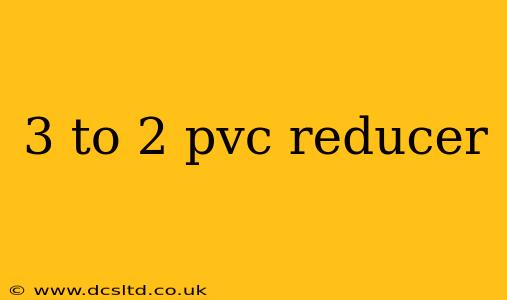Finding the right PVC reducer is crucial for any plumbing or irrigation project. A 3 to 2 inch PVC reducer, in particular, is a common fitting used to smoothly transition from a 3-inch diameter pipe to a 2-inch diameter pipe. This guide will cover everything you need to know about these reducers, from their applications and types to installation and potential issues.
What is a 3 to 2 PVC Reducer?
A 3 to 2 PVC reducer is a plumbing fitting that connects two pipes of different diameters. Specifically, it reduces the pipe size from 3 inches to 2 inches. These reducers are typically made from polyvinyl chloride (PVC), a durable and relatively inexpensive plastic material commonly used in plumbing and irrigation systems. They are designed to maintain a consistent water flow while reducing the pipe's diameter.
Types of 3 to 2 PVC Reducers
Several types of 3 to 2 PVC reducers exist, each suited for different applications and installation methods:
-
Concentric Reducers: These are the most common type, featuring a centered reduction in diameter. The smaller end is aligned perfectly with the center of the larger end, ensuring smooth fluid flow.
-
Eccentric Reducers: These reducers offset the smaller end, allowing for better drainage in applications where sediment or debris might accumulate. This is particularly useful in horizontal runs where you want to keep the flow line consistent and prevent sediment buildup.
-
Reducer Bushings: These are essentially a short section of smaller diameter pipe inserted into a larger diameter pipe. They are simpler and often less expensive than other reducer types but might not offer the same strength or durability, especially under high pressure.
Where are 3 to 2 PVC Reducers Used?
3 to 2 PVC reducers find applications in a wide variety of scenarios, including:
- Plumbing Systems: Reducing pipe size in various home or commercial plumbing setups.
- Irrigation Systems: Connecting pipes of varying sizes in drip irrigation or sprinkler systems.
- Industrial Applications: Used in various industrial processes requiring fluid transfer with differing pipe sizes.
- Water Treatment: Part of larger systems for water filtration or purification.
How to Install a 3 to 2 PVC Reducer
Installing a PVC reducer is generally a straightforward process, requiring only a few basic tools:
- Prepare the Pipes: Ensure both the 3-inch and 2-inch pipes are cut cleanly and square.
- Apply Primer: Apply PVC primer to both the ends of the pipes that will be joined to the reducer. This ensures a better bond with the cement.
- Apply Cement: Apply PVC cement to the inside of the reducer and the outside of the pipe ends.
- Connect the Pipes: Carefully insert the pipes into the reducer, making sure they are fully seated.
- Hold in Place: Hold the joint firmly for the recommended time (check the cement instructions) to allow the cement to set properly.
Important Note: Always refer to the manufacturer's instructions for your specific PVC cement and primer.
What are the common problems with 3 to 2 PVC reducers?
While generally reliable, issues can arise with 3 to 2 PVC reducers:
- Leaks: Improper preparation or application of primer and cement can lead to leaks. Ensure clean, dry pipe ends and follow the cement instructions carefully.
- Cracks: Using excessive force during installation or selecting a reducer of inadequate quality can cause cracks. Always use the correct size reducer and avoid over-tightening.
- Incorrect Sizing: Selecting an incorrect size reducer will lead to compatibility problems and potential performance issues. Ensure accurate measurements before purchasing.
What are the different materials for 3 to 2 reducers?
While PVC is most common, other materials for reducers include:
- CPVC: Chlorinated polyvinyl chloride, offering higher temperature and pressure resistance than standard PVC.
- ABS: Acrylonitrile butadiene styrene, another thermoplastic material used in plumbing systems.
- Metal: Although less common in residential applications, metal reducers (e.g., galvanized steel) might be used in high-pressure or industrial settings.
This guide provides a comprehensive overview of 3 to 2 PVC reducers. Remember to always prioritize safety and follow the manufacturer's instructions for installation and use. Consulting with a qualified plumber for complex installations is always advisable.
